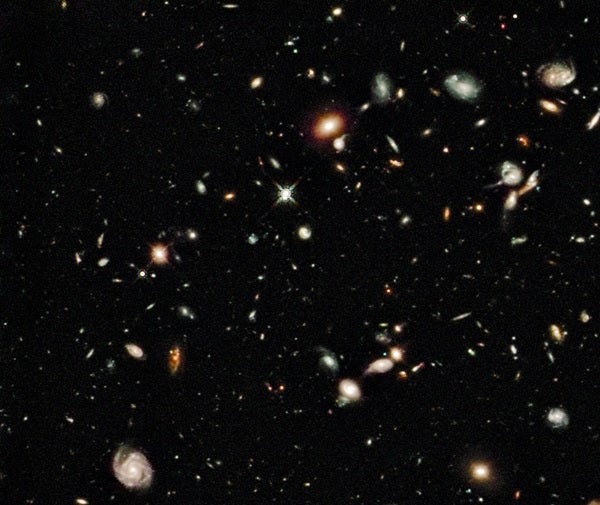More galaxies closer to the moment of the Big Bang will be visible to the James Webb Space Telescope (JWST). The infrared observatory will see farther away, and thus further back in time, than the Hubble Space Telescope has because its mirror will be much larger than Hubble’s and infrared radiation probes earlier epochs due to cosmic redshift. A simulated JWST deep field is shown here. NASA
The Hubble Space Telescope has made the deepest views of the universe that it can, which have been pretty deep and far back in time.
Before NASA launched Hubble in 1990, ground-based telescopes could see clearly only about halfway across the universe. Astronomers knew there must be an “undiscovered country” of primeval galaxies out there, but seeing them required a space telescope to push back the frontier. The pinnacle of that success is the Hubble Ultra Deep Field (HUDF) image, which pushed to 29th magnitude and allowed astronomers to see 95 percent of the way across the universe. HUDF has revealed a feeble glow of a galaxy that existed only 480 million years after the Big Bang.
It took a whopping 500 Hubble orbits around Earth to make the HUDF. To go little more than twice as faint, to 30th magnitude, would require 3,000 Hubble orbits — that’s nearly all of Hubble’s allocated observing time for one year.
At that faintness, the telescope would receive only one photon per minute from distant galaxies. Hubble cameras are state of the art but still cannot perform well with such an anemic trickle of starlight. Electronic “noise” in the telescope’s solid-state detectors would begin to overwhelm the faint starlight.
Given the diminishing return on the orbits that would be needed, there are no plans to push Hubble’s views fainter. The observing time would be more productively spent doing several “deep fields” on different areas of the sky to see if the distribution of galaxies in the universe really does look essentially the same in all directions.
Before NASA launched Hubble in 1990, ground-based telescopes could see clearly only about halfway across the universe. Astronomers knew there must be an “undiscovered country” of primeval galaxies out there, but seeing them required a space telescope to push back the frontier. The pinnacle of that success is the Hubble Ultra Deep Field (HUDF) image, which pushed to 29th magnitude and allowed astronomers to see 95 percent of the way across the universe. HUDF has revealed a feeble glow of a galaxy that existed only 480 million years after the Big Bang.
It took a whopping 500 Hubble orbits around Earth to make the HUDF. To go little more than twice as faint, to 30th magnitude, would require 3,000 Hubble orbits — that’s nearly all of Hubble’s allocated observing time for one year.
At that faintness, the telescope would receive only one photon per minute from distant galaxies. Hubble cameras are state of the art but still cannot perform well with such an anemic trickle of starlight. Electronic “noise” in the telescope’s solid-state detectors would begin to overwhelm the faint starlight.
Given the diminishing return on the orbits that would be needed, there are no plans to push Hubble’s views fainter. The observing time would be more productively spent doing several “deep fields” on different areas of the sky to see if the distribution of galaxies in the universe really does look essentially the same in all directions.
NASA is building the James Webb Space Telescope (JWST) that, because it has a larger mirror than Hubble, will see 10 times fainter than Hubble in infrared light once it launches in 2018. The universe’s expansion reddens light from distant objects, and thus the JWST will observe back in time with its infrared vision. — Ray Villard, Space Telescope Science Institute, Baltimore, Maryland










